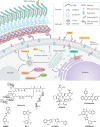Treatment strategies for cryptococcal infection: challenges, advances and future outlook
- PMID: 33558691
- PMCID: PMC7868659
- DOI: 10.1038/s41579-021-00511-0
Treatment strategies for cryptococcal infection: challenges, advances and future outlook
Abstract
Cryptococcus spp., in particular Cryptococcus neoformans and Cryptococcus gattii, have an enormous impact on human health worldwide. The global burden of cryptococcal meningitis is almost a quarter of a million cases and 181,000 deaths annually, with mortality rates of 100% if infections remain untreated. Despite these alarming statistics, treatment options for cryptococcosis remain limited, with only three major classes of drugs approved for clinical use. Exacerbating the public health burden is the fact that the only new class of antifungal drugs developed in decades, the echinocandins, displays negligible antifungal activity against Cryptococcus spp., and the efficacy of the remaining therapeutics is hampered by host toxicity and pathogen resistance. Here, we describe the current arsenal of antifungal agents and the treatment strategies employed to manage cryptococcal disease. We further elaborate on the recent advances in our understanding of the intrinsic and adaptive resistance mechanisms that are utilized by Cryptococcus spp. to evade therapeutic treatments. Finally, we review potential therapeutic strategies, including combination therapy, the targeting of virulence traits, impairing stress response pathways and modulating host immunity, to effectively treat infections caused by Cryptococcus spp. Overall, understanding of the mechanisms that regulate anti-cryptococcal drug resistance, coupled with advances in genomics technologies and high-throughput screening methodologies, will catalyse innovation and accelerate antifungal drug discovery.
Conflict of interest statement
L.E.C. is a co-founder and shareholder in Bright Angel Therapeutics, a platform company for development of novel antifungal therapeutics, and is a consultant for Boragen, a small-molecule development company focused on leveraging the unique chemical properties of boron chemistry for crop protection and animal health. K.R.I., N.M.R., C.F. and N.R. declare no competing interests.
Figures


References
Publication types
MeSH terms
Substances
Grants and funding
LinkOut - more resources
Full Text Sources
Other Literature Sources
Miscellaneous

